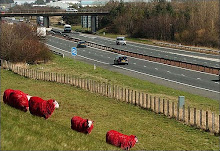| http://term3hjg.blogspot.com/ |
Tuesday, 18 May 2010
Tuesday, 11 May 2010
Shauna McMullan : Blue Spine Project
Blue Spine: An Invitation
As part of the Making Space project, Shauna McMullan is creating a single, long, blue, line of books borrowed and collected from women throughout Scotland.You are invited to take part in this artwork.
Your book needs to:
- Have a blue spine or have blue somewhere in the spine &
- Be written by a woman
You will be invited to celebrate the opening of the artwork and to see your book as part of this collection in The Mitchell Library in May 2010. Following the exhibition your book will be returned to you with a numbered bookmark enclosed, recognising your book’s place within this collection. Your book will need to be borrowed until August 2010 and it is important to include a note of your name, address and contact details with your book.
Please send your book to Blue Spine Collection, Glasgow Women’s Library, 81 Parnie Street, Glasgow, G1 5RH – or drop it off at the Library.
If you have any questions about the Blue Spine collection, please contact us or email Shauna on shauna.mcmullan@womenslibrary.org.uk
......................
The idea of this project interests me , the involvement of all types of people is something that makes the project what it is. The concept of involving people in a project like Shauna McMullan's, is something I am interested in exploring in my current work. Without peoples involvement in this project, the work would be unsucessfull.
Performance Art
- 60's & 70's
- Eva Hesse
- Robert Morris
- Material - product - deterioration
- Decay of work
- Art and Object
- Michael Freed
- Relationship between conceptual art and the 'body art' that emerged from the 1960's
- Chris Burden -'shoot'
- 'Rose-lee Goldberg, Performance Art'
- John Cage
- Marcel Duchamp - 'The Body of Language' 1974

- skill
- audience
- consciousness
- what makes a performance really interesting?
- could be athlete performer - suspense
- sympathy, connection and bond of trust between audience and artist. artist id drawing and pulling energy from the audience
- in everyday life
- in the arts
- in sports and other popular entertainment
- business
- technology
- sex
- ritual - scared and secular
- play
- noise rather than music
- Hugo Ball- surrealist performance
- fluxist movement
- Joseph Boice, Yoko Ono
JOSEPH BEUYS, I Like America and America Likes Me 1974
Arists had to address the movement.
MARCEL DUCHAMP, Mile of String
International Surrealist Exhibition (New York, 1942)
An encounter with the real occurs within like the performance works.
Shoot, Chris Burden
Often works were culturally specific, addressing the contemry social and political situation.
Susan Sontag, 'Against Interpretation, 1964'
What is important, how is to recover our senses...
Ginapane, 1971 - to anger which was unfolding in Vietnam
SDS President Paul Potter - antiwarraly
George Skahel - 'Vietnam Letters'
Monday, 10 May 2010
kohei Nawa

b.1975 Osaka, JapanLives and works in Kyoto, Japan
As a sculptor, Kohei Nawa is concerned with forms and surfaces and how they interact to become objects. His sculptures often exploit the tactile nature of surfaces, as in his ‘Pixcell’ series (2002–), in which he covers the surfaces of objects with glass beads of various sizes. The outer layer suggests a molecular structure, and also references the pixel of the computer screen. Fascinated by how we navigate objects in the virtual world via the internet, Nawa enters keywords into web search engines and creates sculptures based on the images that are returned, with his objects — such as taxidermied animals — sourced from online auction sites. Nawa’s skin of glass beads magnifies the object in some areas and distorts it in others, shifting our perception and questioning how we encounter things in our daily environment. His ‘Pixcell’ sculptures, such as PixCell – Elk#2 2009 shown in APT6, encapsulate Nawa’s longstanding interest in how we come to understand what we see.
Exhibitions (solo): Galerie Vera Munro, Hamburg, Germany, 2009; Miro Foundation, Barcelona, Spain, 2008; Peking Fine Arts, Beijing, China, 2008; Ierimonti Gallery, Milan, Italy, 2007; SCAI The Bathhouse, Tokyo, Japan, 2006. Exhibitions (group): ‘Parallel Worlds’ Museum of Contemporary Art, Tokyo, Japan, 2008; ‘Great New Wave: Contemporary Art from Japan’, Art Gallery of Hamilton, British Columbia, 2008; ‘Roppongi Crossing’, Mori Art Museum, Tokyo, Japan, 2007; Biennial of Valencia, Spain, 2005. www.kohei-nawa.net
http://qag.qld.gov.au/exhibitions/past/recently_archived/apt6/artists/kohei_nawa
Kibong Rhee

1957 Seoul, South Korea
Lives and works in Seoul, South Korea
In the installations of Kibong Rhee, audiences encounter dreamlike scenarios in which everyday objects and images are made extraordinary through the illusion of movement and transformation. Using water and light to manipulate form and matter, Rhee plays on our expectations of the possible and impossible, offering metaphysical speculations that provide his work with a contemplative quality. In one of his recent works, books magically swim within translucent water tanks, a mesmerising act inspired by the artist accidentally dropping a book into the water of his bathtub while reading. In his installation at APT6, There is no place – Shallow cuts 2008, Rhee employs light and vapour to conjure a sublime impression of morning fog as it shrouds and obscures the silhouette of a vast willow tree. A powerfully physical work, it also suggest traditional landscape painting, forming a connection between experience and representation.
Exhibitions (solo): Kukje Gallery, Seoul, South Korea, 2008. Exhibitions (group): ‘Drawn in the Clouds’, Kiasma Museum of Contemporary Art, Helsinki, Finland, 2008; Singapore Biennale, Singapore, 2008; ‘Thermocline of Art: New Asian Waves’, ZKM, Karlsruhe, Germany, 2007.
http://qag.qld.gov.au/exhibitions/past/recently_archived/apt6/artists/kibong_rhee
